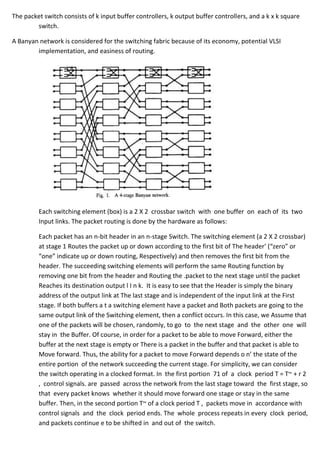Report
Share

Recommended
Recommended
More Related Content
What's hot
What's hot (20)
Concept of Diversity & Fading (wireless communication)

Concept of Diversity & Fading (wireless communication)
Computer Networks Unit 1 Introduction and Physical Layer 

Computer Networks Unit 1 Introduction and Physical Layer
Data Communication And Networking - DATA RATE LIMITS

Data Communication And Networking - DATA RATE LIMITS
Viewers also liked
Viewers also liked (8)
4c Address Mapping, Error Reporting and Multicasting

4c Address Mapping, Error Reporting and Multicasting
More from Ashu0711 (20)
16 x 16 banyan switch
- 1. The packet switch consists of k input buffer controllers, k output buffer controllers, and a k x k square switch. A Banyan network is considered for the switching fabric because of its economy, potential VLSI implementation, and easiness of routing. Each switching element (box) is a 2 X 2 crossbar switch with one buffer on each of its two Input links. The packet routing is done by the hardware as follows: Each packet has an n-bit header in an n-stage Switch. The switching element (a 2 X 2 crossbar) at stage 1 Routes the packet up or down according to the first bit of The header’ (“zero” or “one” indicate up or down routing, Respectively) and then removes the first bit from the header. The succeeding switching elements will perform the same Routing function by removing one bit from the header and Routing the .packet to the next stage until the packet Reaches its destination output l I n k. It is easy to see that the Header is simply the binary address of the output link at The last stage and is independent of the input link at the First stage. If both buffers a t a switching element have a packet and Both packets are going to the same output link of the Switching element, then a conflict occurs. In this case, we Assume that one of the packets will be chosen, randomly, to go to the next stage and the other one will stay in the Buffer. Of course, in order for a packet to be able to move Forward, either the buffer at the next stage is empty or There is a packet in the buffer and that packet is able to Move forward. Thus, the ability for a packet to move Forward depends o n’ the state of the entire portion of the network succeeding the current stage. For simplicity, we can consider the switch operating in a clocked format. In the first portion 71 of a clock period T = T~ + r 2 , control signals. are passed across the network from the last stage toward the first stage, so that every packet knows whether it should move forward one stage or stay in the same buffer. Then, in the second portion T~ of a clock period T , packets move in accordance with control signals and the clock period ends. The whole process repeats in every clock period, and packets continue e to be shifted in and out of the switch.